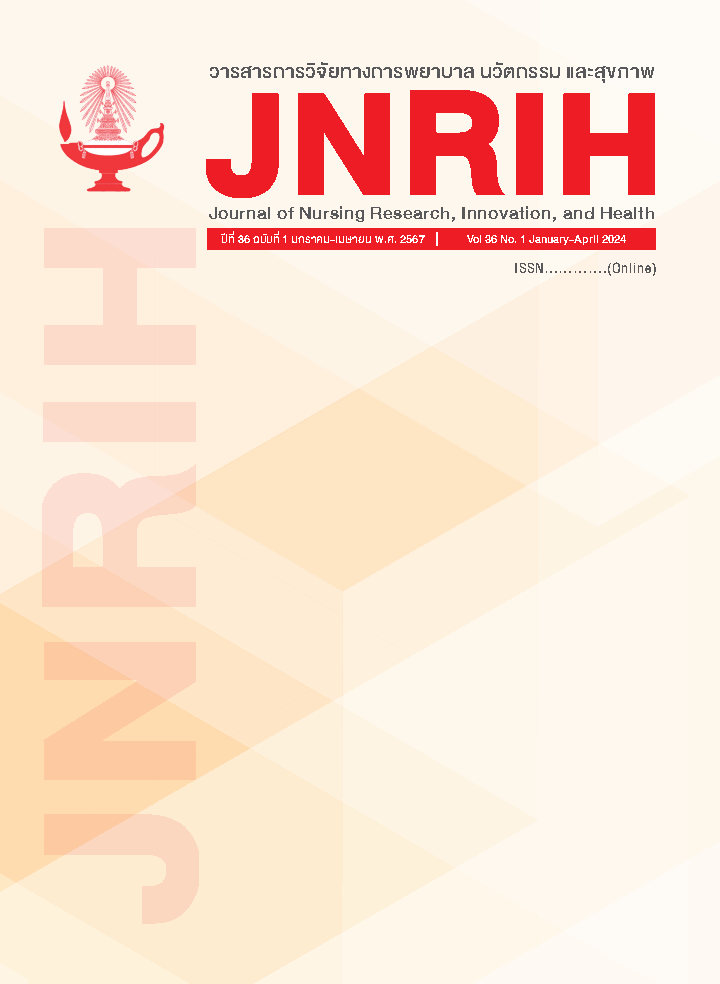ปัจจัยทำนายภาวะสับสนเฉียบพลันในผู้สูงอายุที่เข้ารับบริการในแผนกฉุกเฉิน
คำสำคัญ:
ภาวะสับสนเฉียบพลัน, แผนกฉุกเฉิน, ผู้สูงอายุบทคัดย่อ
วัตถุประสงค์: เพื่อศึกษาปัจจัยทำนายภาวะสับสนเฉียบพลันในผู้สูงอายุที่เข้ารับบริการในแผนกฉุกเฉิน
รูปแบบการวิจัย: การวิจัยเชิงพรรณนาแบบหาความสัมพันธ์เชิงทำนาย
วิธีดำเนินการวิจัย: กลุ่มตัวอย่าง คือ ผู้ที่มีอายุเกิน 60 ปีบริบูรณ์ขึ้นไปทั้งเพศชายและเพศหญิงที่เข้ารับการรักษาในแผนกฉุกเฉินและอุบัติเหตุทุกประเภทในโรงพยาบาลศิริราช โรงพยาบาลพระมงกุฎเกล้า และ โรงพยาบาลราชวิถี จำนวน 220 คน เครื่องมือที่ใช้ในการวิจัย คือ แบบประเมินข้อมูลส่วนบุคคล แบบประเมินภาวะสับสนเฉียบพลัน แบบคัดกรองภาวะสมองเสื่อม แบบประเมินความปวด โดยใช้มาตรวัดแบบตัวเลข และในกรณีผู้สูงอายุที่ไม่สามารถบอกระดับความเจ็บปวดได้ ใช้แบบประเมินความเจ็บปวดสำหรับผู้ที่มีภาวะสมองเสื่อม ผ่านการตรวจสอบการหาค่าความเที่ยง โดยการหาค่าสัมประสิทธิ์แอลฟาครอนบาคของแบบประเมินภาวะสับสนเฉียบพลันและแบบคัดกรองภาวะสมองเสื่อม มีความเที่ยงเท่ากับ .83 และ .79 ตามลำดับ และหาค่าความเที่ยงของแบบประเมินความเจ็บปวดโดยใช้มาตรวัดแบบตัวเลขและแบบประเมิน ความเจ็บปวดสำหรับผู้ที่มีภาวะสมองเสื่อมโดยวิธีการวัดซ้ำ มีค่าความเที่ยงเท่ากับ .77 และ .97 ตามลำดับ
ผลการศึกษา: 1) ผู้สูงอายุที่เข้ารับบริการในแผนกฉุกเฉิน มีภาวะสับสนเฉียบพลัน จำนวน 34 คน จากจำนวนกลุ่มตัวอย่างทั้งหมด 220 คน คิดเป็นร้อยละ 15.45 2) ภาวะการรู้คิดบกพร่อง ประวัติโรคหลอดเลือดสมอง ระยะเวลาการเข้ารับบริการในแผนกฉุกเฉิน ระดับความปวด ภาวะเลือดออกในสมอง และภาวะซึมเศร้า มีความสัมพันธ์เชิงบวกกับภาวะสับสนเฉียบพลันในผู้สูงอายุที่เข้ารับบริการในแผนกฉุกเฉิน อย่างมีนัยสำคัญทางสถิติที่ระดับ .05 (x2 = 9.277, 10.020, rpb= .216, x2 = 9.000, 9.568, 3.874 ตามลำดับ) 3) ตัวแปรที่สามารถร่วมกันทำนายภาวะสับสนเฉียบพลันในผู้สูงอายุที่เข้ารับบริการในแผนกฉุกเฉินได้อย่างมีนัยสำคัญทางสถิติที่ระดับ .05 คือ ภาวะการรู้คิดบกพร่อง (AOR=7.25, 95% CI : 1.681-31.276) ประวัติโรคหลอดเลือดสมอง (AOR=4.74, 95% CI : 1.540-14.579) ระยะเวลาการเข้ารับบริการในแผนกฉุกเฉิน (AOR=6.67, 95% CI : 2.300-19.337) ภาวะเลือดออกในสมอง (AOR=14.72, 95% CI : 2.637-82.151) และภาวะซึมเศร้า (AOR=6.96, 95% CI : 1.274-37.998) โดยมีอำนาจการทำนายร้อยละ 37 (Nagelkerke R2 = .370, p < .05)
สรุป: ผลการศึกษานี้สามารถเป็นแนวทางในการพัฒนาโปรแกรมให้การพยาบาล เฝ้าระวัง และป้องกัน ความเสี่ยงในการเกิดภาวะสับสนเฉียบพลันในผู้สูงอายุที่เข้ารับบริการในแผนกฉุกเฉิน
เอกสารอ้างอิง
Wilson JE, Mart MF, Cunningham C, Shehabi Y, Girard TD, MacLullich AM, et al. Delirium. Nat Rev Dis Primers. 2020; 6(1):90.
Caplan GA, Kurrle SE, Cumming A. Appropriate care for older people with cognitive impairment in hospital. Med J Australia. 2016;205(S10):S12-S5.
Kespichayawattana J, Suvinee Wivatvanit S. Elderly care in the emergency department. J Nursing Science Chulalongkorn University. 2011:23(2): 1-12.
Oliveirae J. e Silva L, Berning MJ, Stanich JA, Gerberi DJ, Murad MH, Han JH, et al. Risk factors for delirium in older adults in the emergency department: a systematic review and meta-analysis. Ann Emerg Med. 2021;78(4):549-65.
Sri-on J, Tirrell GP, Vanichkulbodee A, Niruntarai S, Liu SW. The prevalence, risk factors and short-term outcomes of delirium in Thai elderly emergency department patients. Emerg Med J. 2016;33(1):17-22.
Morley C, Unwin M, Peterson GM, Stankovich J, Kinsman L. Emergency department crowding: a systematic review of causes, consequences and solutions. PloS One. 2018;13(8):e0203316.
Tran NN, Hoang TPN, Ho TKT. Diagnosis and risk factors for delirium in elderly patients in the emergency rooms and intensive care unit of the national geriatric hospital emergency department: A cross-sectional observational study. Int J Gen Med. 2021;14:6505-15.
Kennedy M, Enander RA, Tadiri SP, Wolfe RE, Shapiro NI, Marcantonio ER. Delirium risk prediction, healthcare use and mortality of elderly adults in the emergency department. J Am Geriatr Soc. 2014;62(3):462-9.
Émond M, Grenier D, Morin J, Eagles D, Boucher V, Le Sage N, et al. Emergency department stay associated delirium in older patients. Can Geriatr J. 2017;20(1):10-4.
Bujang MA, Sa’at N, Bakar TMITA, Joo LC. Sample size guidelines for logistic regression from observational studies with large population: emphasis on the accuracy between statistics and parameters based on real life clinical data. MJMS. 2018;25(4):122-30.
Kuladee S, Prachason T. Development and validation of the Thai version of the 4 ‘A’s Test for delirium screening in hospitalized elderly patients with acute medical illnesses. Neuropsychiatr Dis Treat. 2016;12:437-43.
Siri, S., Okanurak, K., Chansirikanjana, S., Kitiyaporn, D., & Jorm, A.F. (2006). Modified informant questionnaire on cognitive decline in the elderly (IQCODE) as a screening test for dementia for Thai elderly. Southeast Asian J Trop Med Public Health. 2006;37(3),587-594.
Royal College of Anesthesiologists of Thailand, and the Pain Education Association of Thailand.Guidelines for developing acute pain relief after surgery, 2nd edition. 2019. Bangkok: Royal College of Anesthesiologists of Thailand.
Boonsawat N, Suraarunsumrit P, Mandee S, Pitiyan S, Pengsorn N, Srinonprasert V, et al. Reliability “and Validity Study of the Thai version of the Pain Assessment in Advanced Dementia” (PAINAD-Th). Int Psychogeriatr. 2020;32(S1):188.
Bo M, Bonetto M, Bottignole G, Porrino P, Coppo E, Tibaldi M, et al. Length of stay in the emergency department and occurrence of delirium in older medical patients. J Am Geriatr Soc. 2016;64(5): 1114-9.
Inouye SK. Delirium in older persons. NEJM. 2006;354(11):1157-65.
Zipser CM, Deuel J, Ernst J, Schubert M, von Känel R, Böttger S. The predisposing and precipitating risk factors for delirium in neurosurgery: a prospective cohort study of 949 patients. Acta Neurochir. 2019;161(7):1307-15.
Falk A, Kåhlin J, Nymark C, Hultgren R, Stenman M. Depression as a predictor of postoperative delirium after cardiac surgery: a systematic review and meta-analysis. Interact Cardiovasc Thorac Surg. 2021;32(3):371-9.
Lumyong T. Selected factors related to acute Confusion states in mechanically ventilated patients admitted to intensive care units [Thesis]. Bangkok: Chulalongkorn University; 2011. 100 p. (In Thai)
ดาวน์โหลด
เผยแพร่แล้ว
ฉบับ
ประเภทบทความ
สัญญาอนุญาต
ลิขสิทธิ์ (c) 2024 วารสารพยาบาลศาสตร์ จุฬาลงกรณ์มหาวิทยาลัย

อนุญาตภายใต้เงื่อนไข Creative Commons Attribution-NonCommercial-NoDerivatives 4.0 International License.
ลิขสิทธิ์ของบทความที่ตีพิมพ์เป็นของวารสารพยาบาลศาสตร์ จุฬาลงกรณ์มหาวิทยาลัย ทั้งฉบับตีพิมพ์เป็นรูปเล่มและเอกสารออนไลน์



